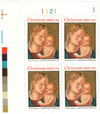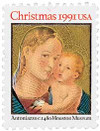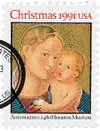
# 2578 - 1991 29c Traditional Christmas: Madonna and Child
US #2578
1991 Christmas
- Traditional Christmas
- Non-denominated because of expected rate change
- Was valid for use on international mail
Category of Stamp: Commemorative
Set: Christmas
Value: 29¢, the First-class mail rate
First Day of Issue: October 17, 1991
First Day City: Houston, Texas
Quantity Issued: 701,000,000 (104,000,000 as sheet stamps and 300,000,000 as booklet stamps
Printed by: Bureau of Engraving and Printing
Printing Method: lithographed and engraved
Format: Panes of 50 and Booklets of 20 (2 panes of 10)
Perforations: 11
Reason the stamp was issued: This traditional Christmas stamp was issued for the 1991 holiday season.
About the stamp design: The design for the 1991 Christmas stamp is from a painting housed at the Museum of Fine Arts of Houston, Texas. The 15th-century painting is called Madonna and Child With Donor, by Antoniazzo Romano of Rome. It was painted in tempera with gold leaf. In the original painting, a man is kneeling in the left corner. This is thought to be the donor mentioned in the title of the work.
Special design details: The US Postal Service was hoping to be approved to raise the first-class mail rate to 30¢, but the decision hadn’t been made by the time the Christmas stamps went to print. As a result, they were printed without a denomination. The USPS was not approved for a rate increase, so the cost of the stamp remained at 29¢
First Day City: The Traditional Christmas stamp was dedicated at the Houston museum, where the original painting is on display. The curator who nominated the painting for use on a stamp was on e of the speakers at the ceremony.
Unusual thing about this stamp: The USPS gave post offices permission to allow this stamp to be used on mail to foreign destinations. Usually stamps without denominations weren’t permitted by the Universal Postal Union. The traditional and contemporary Christmas stamps were exempted from the rule in 1991, as long as additional postage was added to make up the rate difference.
About the Christmas series: By the early 1960s, the US Post Office was receiving 1,000 letters a year (for several years) asking for a Christmas-themed stamp to frank their holiday mail. The idea was approved and the US issued its first Christmas stamp on November 1, 1962.
The stamp was wildly popular, featuring popular holiday decorations of a wreath and candles. The Post Office Department had expected there would be a great demand for the issue, so they printed 350 million stamps – the largest print run for a special stamp up to that time. Those 350 million stamps sold out quickly, leading the Bureau of Engraving and Printing to produce more stamps – reaching over 860 million by the end of the year.
While the Christmas stamp was very popular, it wasn’t without its detractors. Some didn’t agree with the idea of the post office issuing a stamp honoring a religious holiday. Others wanted Christmas stamps that were more religious. The Post Office would continue to issue Christmas stamps in the coming years that featured the National Christmas Tree, seasonal plants, and an angel in 1965. The angel was considered less controversial because angels are included in many religions, not just Christianity.
In 1966, the Post Office came up with a plan to produce Christmas stamps utilizing classic paintings of the Madonna and Child. These stamps wouldn’t violate the separation of church and state because they were a celebration of culture. On November 1, 1966, they issued the first US Madonna and Child stamp in Christmas, Michigan. The stamp featured the 15th century painting, Madonna and Child with Angels, by Flemish painter Hans Memling.
That stamp was very popular and over 1.1 billion were printed. The same design was used again the following year, however, the 1967 stamp was larger and showed more of the painting. The stamp’s continued popularity led the Post Office to issue another traditional Christmas stamp in 1968, this time picturing the Angel Gabriel. For the 1969 issue, they reverted back to the non-religious theme, with a stamp picturing a painting called Winter Sunday in Norway, Maine.
The Post Office made a big change in 1970. To keep people in both camps happy, they issued one traditional Christmas stamp, picturing a classic painting of the Nativity, plus a block of four picturing Christmas toys. That decision proved popular and they have continued to issue stamps with both traditional and contemporary Christmas themes ever since.
History the stamp represents: Antoniazzo Romano (c. 1430-1510) was a leading painter in Rome during the last half of the 15th century. Romano painted in a realistic style, using light and shadow to add to the depth of his subjects.
US #2578
1991 Christmas
- Traditional Christmas
- Non-denominated because of expected rate change
- Was valid for use on international mail
Category of Stamp: Commemorative
Set: Christmas
Value: 29¢, the First-class mail rate
First Day of Issue: October 17, 1991
First Day City: Houston, Texas
Quantity Issued: 701,000,000 (104,000,000 as sheet stamps and 300,000,000 as booklet stamps
Printed by: Bureau of Engraving and Printing
Printing Method: lithographed and engraved
Format: Panes of 50 and Booklets of 20 (2 panes of 10)
Perforations: 11
Reason the stamp was issued: This traditional Christmas stamp was issued for the 1991 holiday season.
About the stamp design: The design for the 1991 Christmas stamp is from a painting housed at the Museum of Fine Arts of Houston, Texas. The 15th-century painting is called Madonna and Child With Donor, by Antoniazzo Romano of Rome. It was painted in tempera with gold leaf. In the original painting, a man is kneeling in the left corner. This is thought to be the donor mentioned in the title of the work.
Special design details: The US Postal Service was hoping to be approved to raise the first-class mail rate to 30¢, but the decision hadn’t been made by the time the Christmas stamps went to print. As a result, they were printed without a denomination. The USPS was not approved for a rate increase, so the cost of the stamp remained at 29¢
First Day City: The Traditional Christmas stamp was dedicated at the Houston museum, where the original painting is on display. The curator who nominated the painting for use on a stamp was on e of the speakers at the ceremony.
Unusual thing about this stamp: The USPS gave post offices permission to allow this stamp to be used on mail to foreign destinations. Usually stamps without denominations weren’t permitted by the Universal Postal Union. The traditional and contemporary Christmas stamps were exempted from the rule in 1991, as long as additional postage was added to make up the rate difference.
About the Christmas series: By the early 1960s, the US Post Office was receiving 1,000 letters a year (for several years) asking for a Christmas-themed stamp to frank their holiday mail. The idea was approved and the US issued its first Christmas stamp on November 1, 1962.
The stamp was wildly popular, featuring popular holiday decorations of a wreath and candles. The Post Office Department had expected there would be a great demand for the issue, so they printed 350 million stamps – the largest print run for a special stamp up to that time. Those 350 million stamps sold out quickly, leading the Bureau of Engraving and Printing to produce more stamps – reaching over 860 million by the end of the year.
While the Christmas stamp was very popular, it wasn’t without its detractors. Some didn’t agree with the idea of the post office issuing a stamp honoring a religious holiday. Others wanted Christmas stamps that were more religious. The Post Office would continue to issue Christmas stamps in the coming years that featured the National Christmas Tree, seasonal plants, and an angel in 1965. The angel was considered less controversial because angels are included in many religions, not just Christianity.
In 1966, the Post Office came up with a plan to produce Christmas stamps utilizing classic paintings of the Madonna and Child. These stamps wouldn’t violate the separation of church and state because they were a celebration of culture. On November 1, 1966, they issued the first US Madonna and Child stamp in Christmas, Michigan. The stamp featured the 15th century painting, Madonna and Child with Angels, by Flemish painter Hans Memling.
That stamp was very popular and over 1.1 billion were printed. The same design was used again the following year, however, the 1967 stamp was larger and showed more of the painting. The stamp’s continued popularity led the Post Office to issue another traditional Christmas stamp in 1968, this time picturing the Angel Gabriel. For the 1969 issue, they reverted back to the non-religious theme, with a stamp picturing a painting called Winter Sunday in Norway, Maine.
The Post Office made a big change in 1970. To keep people in both camps happy, they issued one traditional Christmas stamp, picturing a classic painting of the Nativity, plus a block of four picturing Christmas toys. That decision proved popular and they have continued to issue stamps with both traditional and contemporary Christmas themes ever since.
History the stamp represents: Antoniazzo Romano (c. 1430-1510) was a leading painter in Rome during the last half of the 15th century. Romano painted in a realistic style, using light and shadow to add to the depth of his subjects.













